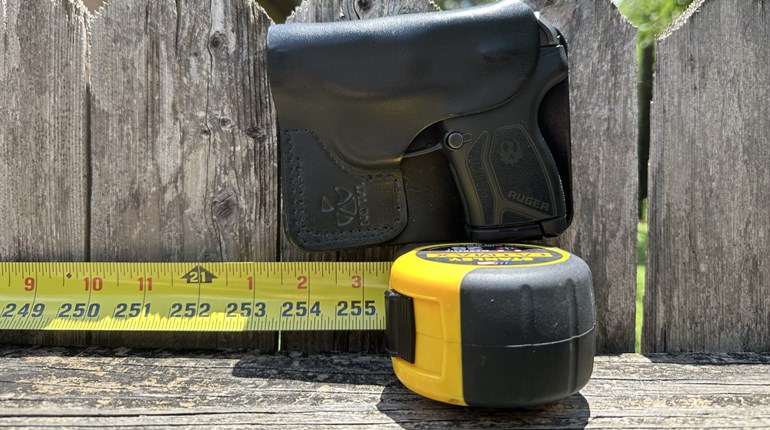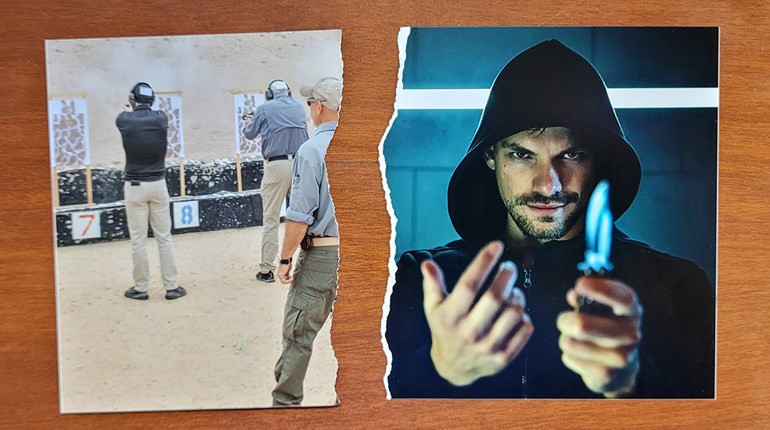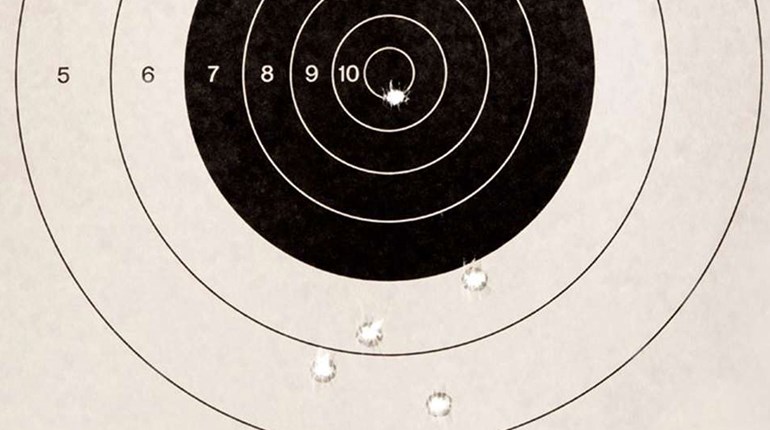
You’ve just been violently attacked and forced to use your legally carried semi-auto handgun to defend yourself. You fired a number of rounds, moved rapidly away from the threat area and found cover in what appears to be a defensible position. With a racing heart and shaking hands you scan the immediate area, but don’t see any imminent threats. The situation is quiet at the moment, but you don’t know if the threat is truly over. What you do know is that you fired a number of rounds and aren’t sure how many remain in the gun.
Common sense says getting that pistol fully recharged—immediately—is an excellent idea. And retaining the partially expended magazine, in case it’s needed later, is also smart. That’s especially true if you’re carrying a compact semi-auto with reduced capacity. There are two reloading techniques that can do that: the Tactical Reload (TAC) and the Reload With Retention (RWR).


The TAC reload begins by dropping the support hand from the gun and grabbing the spare magazine. The magazine is held by the thumb and forefinger with the remaining three fingers spread outward to form a pocket. The new magazine is brought to the gun, where the partial magazine is ejected into the pocket formed by the three splayed fingers, the new magazine inserted, and the partial magazine then stowed somewhere on the person.
You’ve just been violently attacked and forced to use your legally carried semi-auto handgun to defend yourself. You fired a number of rounds, moved rapidly away from the threat area and found cover in what appears to be a defensible position. With a racing heart and shaking hands you scan the immediate area, but don’t see any imminent threats. The situation is quiet at the moment, but you don’t know if the threat is truly over. What you do know is that you fired a number of rounds and aren’t sure how many remain in the gun.
Common sense says getting that pistol fully recharged—immediately—is an excellent idea. And retaining the partially expended magazine, in case it’s needed later, is also smart. That’s especially true if you’re carrying a compact semi-auto with reduced capacity. There are two reloading techniques that can do that: the Tactical Reload (TAC) and the Reload With Retention (RWR).
The TAC reload begins by dropping the support hand from the gun and grabbing the spare magazine. The magazine is held by the thumb and forefinger with the remaining three fingers spread outward to form a pocket. The new magazine is brought to the gun, where the partial magazine is ejected into the pocket formed by the three splayed fingers, the new magazine inserted, and the partial magazine then stowed somewhere on the person.
The TAC reload was introduced many years ago by Col. Jeff Cooper, using his preferred Model 1911 pistol. Its proponents state it is the fastest way to recharge a gun while leaving it unloaded for the minimum amount of time. That’s true—to a point. As the support hand reaches for the fresh magazine the gun is still gripped by the firing hand with the partially expended magazine in place and it can certainly be fired. The drawbacks to this technique occur when the magazine exchange actually takes place. There is more than enough time to get Mr. Murphy drooling in anticipation of a personal visit.
One obvious pitfall is that the shooter is required to make complex manipulations with two magazines in one hand at the same time, under what would certainly be described as a “high-stress” situation. Many CCW licensees only carry one spare magazine. To have all of their ammunition (except for the one round in the chamber) juggling around in one hand under those conditions invites a number of potential problems, which was evident even with the slender single-stack 1911 magazines that Col. Cooper used when he introduced the technique. The double-stack magazines used in many handguns today are significantly thicker and have a wider base plate. They’re a lot more to handle, even for those with large hands.
Prior to recent rule changes there were situations occurring during International Defensive Pistol Association (IDPA) action pistol matches where a TAC reload could be advantageous during a course of fire. As a IDPA safety officer, I watched a number of shooters attempt them. Some dropped one or both magazines. Some got confused in “the heat of the moment” and shoved the partial magazine back into the gun; only to realize their mistake when their gun went to slide lock three rounds later. A few others, trying to juggle two magazines failed to properly seat the fresh magazine, and it fell out of the gun on their first shot after the reload. These are all “operator errors.” They might be corrected with increased practice, and the TAC reload does require considerable practice to master. Sometimes, however, the gun itself works against a TAC reload.
The key to a quick TAC reload is that the magazine in the gun must eject smoothly into the hand that is bringing the new magazine to the gun. It should do so with only the actions of the shooting hand. Not all semi-auto handguns will do that.
Guns with a heel-style magazine release located on the gun’s butt, or those with a magazine release located other than the American-style behind-the-trigger-guard position, render a true TAC reload difficult, at best. You can’t eject these magazines with just the gun hand. They normally require at least some effort from the support hand to release them. If that support hand is busy juggling a fresh magazine, the magazine exchange becomes problematic. Even guns with the American-style magazine release may not smoothly drop the magazine.
Compact semi-auto pistols have a shortened butt/magazine well and reduced ammunition capacities in the six- to 10-round range. They’re very popular for concealed carry and are the most likely to benefit from a quick recharging in a hazardous situation. But their reduced grip size creates potential problems with a smooth magazine release. Flush-mounted magazines (often six to eight rounds) put the shooter’s pinky finger curled under the butt in a normal shooting group. That creates an awkward grip that many find uncomfortable and contributes to a lack of recoil control. To remedy this, many gunmakers will place a finger-extension base plate on the magazine that allows a full-hand grip. Some even provide an extended magazine, with a polymer collar that mates perfectly with the gun’s abbreviated grip, adds an extra round or two in the magazine, and extends the grip on the gun beyond the shortened butt.
Both of these popular accessories will put the palm, or pinky finger, of the shooting hand in direct contact with the magazine itself and can prevent it from dropping free. The shooter is then faced with the task of digging the magazine out with the support hand while trying to maintain control of the fresh magazine. The term “drop free” doesn’t always mean the magazine will actually drop free, and a shooter can quickly determine whether their chosen concealed-carry pistol actually allows this. If not, the RWR could be a be a better choice.


Reload With Retention
The RWR eliminates many of the pitfalls of the TAC reload by doing things in reverse. When the decision is made to reload, the support hand removes the partial magazine from the gun. It’s then stowed somewhere on the body and the fresh magazine is grabbed and inserted.
One advantage to the RWR is that it does not depend upon the magazine dropping free. The support hand strips it from the gun. Unlike the TAC reload, there are no complex fine-motor manipulations required. The movements used are simple gross-motor skills—the ones most likely to play back under stress—and they are basic everyday movements that are already familiar to any shooter. Little practice is required to master this reloading technique. Another major advantage is the shooter is only handling one magazine at a time. The key to a quick and positive RWR is where do you carry your spare magazine, and where do you stow the partial magazine in relation to it?
For those that wear slacks and carry their spare magazine on their weak side, it’s simple—the partial magazine goes into the weak-side front pants pocket and the hand is then in a perfect position to grab the spare as it comes out of the pocket. If the spare is carried in a purse or fanny pack, that’s where the partial should go. Or, the partial can be dropped into any convenient pocket, or even down the inside front of a blouse or shirt. Stowing the partial magazine so that you can quickly access the fresh magazine is really the only practice needed here.

Drilling It In
It’s a more “Murphy Proof” technique than the TAC reload, and more likely to be properly executed under stress. It’s a simple technique, and the results of some recent tests I conducted indicate it can actually be faster than the TAC reload. For these tests I wore my normal everyday carry (EDC) gear—a strong-side outside-the-waistband (OWB) pancake holster with a single OWB magazine carrier on my weak side. A short-sleeved Safari-style shirt was worn to provide concealment as an outer garment covering the holstered handgun is a common carry method.
The gun was a Smith & Wesson M&P standard model with a 4.25-inch barrel. This is a service-size pistol that provides a full grip without contacting the magazine. That allows the magazines to literally shoot out of the gun. It does use a double-stack magazine, but other than a 1911 it’s about as “TAC friendly” a choice as you’ll find. Three different tests were done, with five runs made on each test.
I set up a IDPA target at 5 yards. My PACT timer was set for a 3-second delay. I faced the target, and at the buzzer the gun was drawn smoothly—no hurry—and with a two-handed freestyle grip one shot was fired at the target. The reload was then initiated and completed as quickly as possible, with the retained magazine going into my weak (left-side) pants pocket, and a second two-handed shot was immediately fired at the same target. The split time recorded on the timer was shot-to-shot time with the reload in between. That is the total reload/recovery time.
There are several ways to measure reload time. My opinion is that shot-to-shot (the last shot before the reload to the first shot after the reload) is the most valid. It shows the time for the entire sequence, which not only includes the reload, but the time required to achieve the proper grip on the gun and make an accurate shot after the reload. The purpose of the target was to track the shots to determine if I had the proper grip and sight alignment following the reload.
Test one was the RWR. The times from the two-handed first shot to the two-handed after-reload shot were very consistent. They ran from 3.65 to 3.78 seconds for the five runs, with accurate center-of-mass (COM) hits.
Test two was the TAC reload with the magazine stowed to allow a two-handed second shot. The retained magazine went into the same weak-side pants pocket as the RWR test. The fastest of the five runs was 5.56 seconds. Three ran between 5.75 and 5.88 seconds. One time of 6.81 seconds was due to bobbling the mags, a problem not uncommon with the TAC reload. The COM hits were accurate.
Test three was the TAC reload, but timed from the first two-handed shot to a second one-hand shot. I did not stow the magazine. I held it in my support hand while the second shot was fired with my strong hand. The first run was the fastest at 3.42 seconds, but the hit on the target was poor. I rushed the shot and hit the target’s shoulder. For the remaining four runs I took the time to make a COM hit with the strong hand and they ran from 3.89 to 4.07 seconds. Some slight bobbles on the magazine exchange occurred.
Even without stowing the magazine—just getting the gun recharged—those times are slightly slower than a smoothly executed RWR. Had the situation required multiple shots, I would have been left shooting with one hand, while trying to figure out what to do with the magazine clutched in my other.
The TAC reload looks “Tacticool” and is taught at a number of upscale shooting academies. The RWR is largely ignored. Both can achieve the same result—recharge the gun quickly and keep the unfired rounds in the partially expended magazine for later use. Which is the best for you depends largely on your mode of carry, the gun you carry, your normal dress and just how much practice time you are willing expend to make sure you get it right. Each shooter will have to determine what works best for them. But, it’s worth the effort.
If you ever find yourself crouched behind cover with your heart racing and your hands shaking, you’ll be the only one there to get a fresh magazine into that pistol. Success will depend upon getting it done quickly on the first try.
 Feed with the Finest
Feed with the Finest
There are two words that come to mind when high-quality 1911 magazines are discussed: Wilson and Combat. The company known for high-end 1911s and 1911 parts produces some of the most sought-after fodder sources on the market, and for good reason. Their quality and reliability are second to none, and Wilson Combat’s new Elite Tactical 10-round 9 mm 1911 magazines promise to continue this exemplary reputation.
Built from aircraft-grade stainless steel, the magazine body resists corrosion. A fiber-filled nylon follower is self-lubricating and promotes proper round feeding. The familiar observation slots grace the side of the magazine and allow confirmation of rounds remaining at a glance. A heavy-duty spring with maximum tensile strength ensures a long service live, while the basepad is removable and can be exchanged with other basepad configurations.
Wilson Combat guarantees its products to be free from defects and will repair or replace any magazine that fails in normal operation. All magazines are 100-percent U.S.-made and are designed to fit all standard, full-size 9 mm 1911 models. Magazines designed to fit compact 1911 models are also available.
MSRP: $39.95; (800) 955-4856, wilsoncombat.com




































